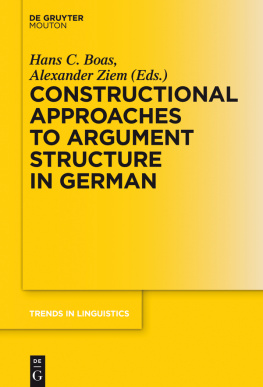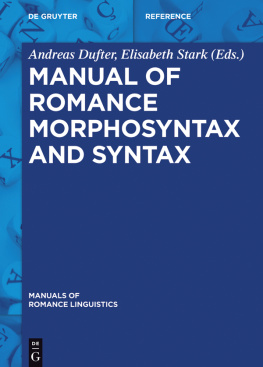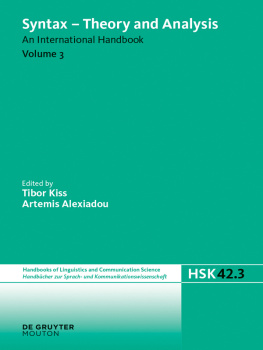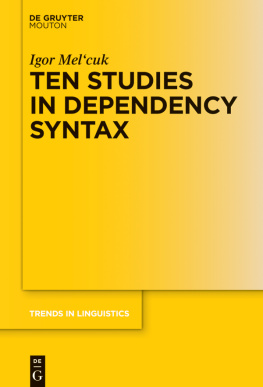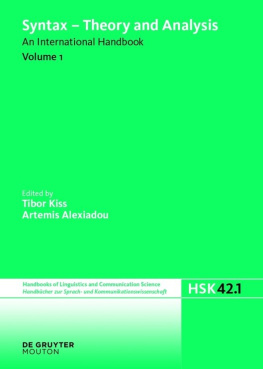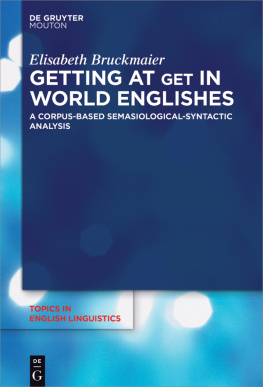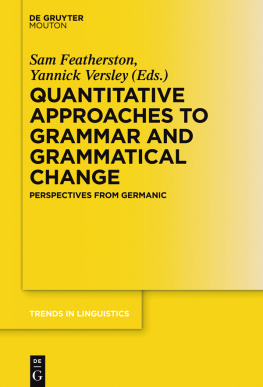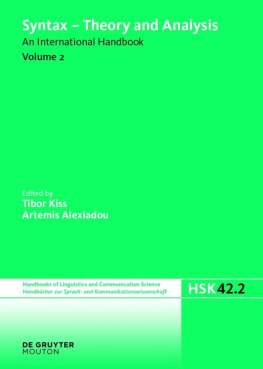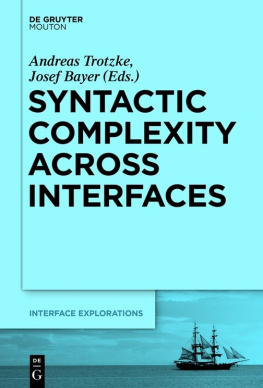Contents
Guide

Hans C. Boas, Alexander Ziem (eds.)
Constructional Approaches to Syntactic Structures in German
Trends in Linguistics
Studies and Monographs

Editor
Volker Gast
Editorial Board
Walter Bisang
Hans Henrich Hock
Natalia Levshina
Heiko Narrog
Matthias Schlesewsky
Amir Zeldes
Niina Ning Zhang
Editor responsible for this volume
Natalia Levshina
Volume 322

ISBN 978-3-11-045472-7
e-ISBN (PDF) 978-3-11-045715-5
e-ISBN (EPUB) 978-3-11-045516-8
ISSN 1861-4302
Library of Congress Control Number: 2018017453
Bibliographic information published by the Deutsche Nationalbibliothek
The Deutsche Nationalbibliothek lists this publication in the Deutsche Nationalbibliografie;
detailed bibliographic data are available in the Internet at http://dnb.dnb.de.
2018 Walter de Gruyter GmbH, Berlin/Boston
www.degruyter.com
Preface
This volume grew out of our collective realization that over the last decade a great deal of constructional research has been published on German, in German. At the same time, however, very few constructional studies on German were published in English or other languages, which could make the results of that research available to a broader international audience. This situation is not unique to Construction Grammar, but spans the entire field of Germanic Linguistics: There is a lot of excellent linguistic research published on German that is written in German and is therefore not available to those who do not know German. As a result, too many insights that are relevant to linguistics more generally (not only to Germanic Linguistics) have gone unnoticed by too many linguists over the years.
In order to address this problem, we decided to put together this volume presenting some of the latest research on a variety of grammatical constructions in present-day German. Among the publications that emerged out of the research group German Construction Grammar hosted in Dsseldorf (goo.gl/khzwmT), this volume is the first one that addresses the English-speaking scientific community. As such, this volume offers a number of easily accessible, yet comprehensive and sophisticated studies on various grammatical constructions. By doing so, this volume also pays attention to Valency Theory, which has figured quite prominently in Germanic Linguistics over the past decades. Valency Theory is of interest to Construction Grammar because of its connection to Frame Semantics, the sister theory of Construction Grammar, which seeks to systematically use semantic frames to account for the meaning of lexical units and constructions more generally. Frame Semantics, as developed by Charles J. Fillmore and his associates over several decades, pays a great deal of attention to valency, especially in the context of the Berkeley FrameNet project (http://framenet.icsi.berkeley.edu), which seeks to create a corpus-based lexicographic database of English based on the principles of Frame Semantics. Both of us are thankful for having had the privilege to work with the FrameNet team under Fillmores direction for a number of years, and to see the beginnings of the so-called Constructicon, a database of grammatical constructions of English that grew out of FrameNet. Both the Berkeley FrameNet and the Constructicon project have served as the basis for parallel projects for a number of other languages, and we are happy to have seen them grow over the past years.
Putting together an edited volume is a complex enterprise. Our warmest thanks go to the reviewers that provided valuable feedback on the papers in this volume: Alexander Bergs, Arnulf Deppermann, Stefan Engelberg, Mirjam Fried, Juliane Goschler, Martin Hilpert, Thomas Hoffmann, Wolfgang Imo, Clemens Knobloch, Alexander Lasch, Stefan Mller, Jan-Ola stman, Marc Pierce, Jouni Rostila, Josef Ruppenhofer, Hans-Jrg Schmid, Thomas Schmidt, Doris Schnefeld, Daniel Wiechmann, Stefanie Wulff, Amir Zeldes, and Arne Zeschel. Without their help, this volume would never have materialized. We are also grateful to our colleagues Johanna Flick, Anastasia Neumann, Bernhard Ost, and Marc Pierce, who gave us many useful comments on an earlier version of our introductory chapter, helping us balance the complexities of German syntax (and Construction Grammar). Thank you so much!
In addition, we would like to thank the various people with de Gruyter who have accompanied the project over the years, specifically Julia Miess and Birgit Sievers. We are also grateful for the detailed feedback from an anonymous reviewer and the support from the series editor of TiLSM, Volker Gast, who contributed invaluable feedback on previous versions of our manuscript.
Finally, we would like to express our greatest gratitude to our wonderful families, who always were, and still are, so understanding and supportive, especially when it comes to us spending extra time away at conferences, workshops, and other meetings. Without their continuous support this volume would not have seen the light of day. Thank you Andrea and Claire; thank you Joni, Lena, Linnea, and Sophia!
Austin and Dsseldorf, June 2018
Hans C. Boas and Alexander Ziem
Hans C. Boas and Alexander Ziem
Approaching German syntax from a constructionist perspective
Note: We would like to thank Johanna Flick, Martin Hilpert, Thomas Hoffmann, Alexander Lasch, Marc Pierce, and Bernhard Ost for very helpful comments on an earlier draft of this chapter. We are also grateful to the series editor Volker Gast and an anonymous reviewer for helpful comments. The usual disclaimers apply.
1Introduction
Over the last decade or so, Construction Grammar (CxG) has evolved into an influential paradigm in linguistic research. CxG subsumes a family of related constructional approaches to language including Cognitive Construction Grammar (Lakoff 1987, Goldberg 1995, Boas 2013), Berkeley Construction Grammar (Fillmore et al. 1988, Kay and Fillmore 1999, Fillmore 2013), Sign-based Construction Grammar (SBCG; Sag 2011, Boas and Sag 2012, Michaelis 2013), Radical Construction Grammar (Croft 2001, 2013), and Cognitive Grammar (Langacker 1987, 2008; Broccias 2013), among others (for an overview see Hoffmann/Trousdale 2013, Ziem and Lasch 2013, and Lasch and Ziem 2014). Although such approaches differ not only in methodological terms but also with respect to the types of linguistic phenomena addressed, they all embrace the view that both lexicon and grammar essentially consist of constructions, i.e. non-compositional (and compositional) form-meaning pairings of varying abstractness and syntagmatic complexity. Building on this basic assumption, this volume investigates a variety of grammatical phenomena in German from a constructional point of view, including argument structure constructions, prepositional constructions, comparative correlatives, and relative clause constructions. Each contribution is anchored in a constructional approach to language, and the constructional nature of each phenomenon addressed is demonstrated in detail.
Why German? Since its beginnings in the 1980s, constructional research has primarily focused on English, although languages such as Czech, Finnish, French, and Japanese have also received considerable attention. Since the 2000s, there has also been a significant amount of constructional research on German, including Jrventausta (2006), Imo (2007), Nikula (2007), Chang (2008), Cloene and Willems (2006a, b), Deppermann (2007), Rostila (2008), Felfe (2012), Zeldes (2012), Hein (2015), and Lasch (2017); as well as a number of edited volumes such as Fischer and Stefanowitsch (2006), Stefanowitsch and Fischer (2008), Gnthner and Bcker (2009), Engelberg et al. (2011), Lasch and Ziem (2011), Lasch and Ziem (2014), Ziem and Lasch (2015); and a special issue of Zeitschrift fr Germanistische Linguistik (Knobloch 2009). However, almost all of the constructional research on German has been written in German (exceptions include Hens (1996), Michaelis and Ruppenhofer (2001), Boas (2003), Hilpert (2008, 2009), and Auer and Pfnder (2011)). To date, there exists relatively little constructional research on German written in English, which denies linguists without knowledge of German access to the insights of these German linguists.

